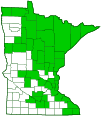longbract frog orchid
(Dactylorhiza viridis)
Conservation • Wetland • Description • Habitat • Ecology • Use • Distribution • Taxonomy
Conservation Status |
|
|||||||
| IUCN Red List | not listed |
|||||||
| NatureServe | NNR - Unranked SNR - Unranked |
|||||||
| Minnesota | not listed |
|||||||
Wetland Indicator Status |
||||||||
| Great Plains | FACU - Facultative upland |
|||||||
| Midwest | FAC - Facultative |
|||||||
| Northcentral & Northeast | FAC - Facultative |
|||||||
Description |
||
The stem has 2 to 6 alternate leaves, at least 1 of them clearly above the base. They wrap around (sheathe) the stem at the base, without a leaf stalk or stalk-like inflated sheath. The modified leaf (bract) subtending each flower is 2 to 3 times longer than that flower. The long, strap-shaped lower petal (lip) has three forward-pointing teeth at the tip. The middle tooth is reduced and usually inconspicuous. The spur is inconspicuous. It is pouch shaped, 1 ⁄16″ to ⅛″ (2 to 3 mm) long, and is tucked behind the lip. The mouth of the spur is covered by a membrane with a small opening. |
||
Height |
||
6″ to 22″ |
||
Flower Color |
||
Greenish to yellowish, often tinged with purple or reddish-brown |
||
Similar Species |
||
Habitat |
||
Moderately moist to wet. Open deciduous woodlands, shrubby woodland borders, and thickets. |
||
Ecology |
||
Flowering |
||
May 20 to August 10 |
||
Pests and Diseases |
||
|
||
Use |
||
|
||
Distribution |
||||
|
Sources 2, 3, 4, 5, 7, 25, 28, 29, 30. The map at left includes historical records. Due to ongoing habitat loss, it may include counties where the longbract frog orchid is no longer found. |
|||
| 5/8/2023 | ||||
Nativity |
||||
Native |
||||
Occurrence |
||||
Extremely widespread; common but declining |
||||
Taxonomy |
|||
| Kingdom | Plantae (Plants) | ||
| Division | Tracheophyta (Vascular Plants) | ||
| Subdivision | Spermatophytina (Seed Plants) | ||
| Class | Liliopsida (Monocots) | ||
Order |
Asparagales (Agaves, Orchids, Irises, and Allies) | ||
Family |
Orchidaceae (orchids) | ||
| Subfamily | Orchidoideae | ||
| Tribe | Orchideae | ||
| Subtribe | Orchidinae |
||
Genus |
Dactylorhiza (marsh orchids) | ||
Long-bract frog orchid was originally given the Latin name Satyrium viride by Carl Linnaeus in 1753. It was later transferred to the bog orchid genus with the name Habenaria viridis. Later, it was placed in the monotypic (containing only one species) genus Coeloglossum. Based on molecular DNA studies published in 1997, it was suggested that it be moved to the genus Dactylorhiza. This suggestion was controversial and not widely accepted outside of Brittan. Recently, an extensive review (Bateman & Rudall, 2017) of the morphology, the phylogeny, and the scientific evidence of the two species Dactylorhiza viridis and Dactylorhiza iberica and the genus Coeloglossum was published in the Kew Bulletin in 2018 (published online December 23, 2017). The authors concluded that “there is no question in our minds that the most appropriate taxonomic decision, based on extensive and diverse scientific evidence, is to retain both viridis and iberica within Dactylorhiza.” The former genus Coeloglossum is now obsolete, and the widely used name Coeloglossum viride is a synonym of Dactylorhiza viridis. |
|||
Synonyms |
|||
Coeloglossum bracteatum Coeloglossum viride Coeloglossum viride ssp. bracteatum Coeloglossum viride var. islandicum Coeloglossum viride var. virescens Coeloglossum viride var. viride Habenaria bracteata Habenaria viridis Habenaria viridis var. bracteata Habenaria viridis var. interjecta |
|||
Common Names |
|||
bracted green orchid bracted orchid frog orchid frog orchis long-bract frog orchid long-bract green orchis long-bracted frog orchid long-bracted orchid longbract frog orchid longbract orchid |
|||
Glossary
Bract
Modified leaf at the base of a flower stalk, flower cluster, or inflorescence.
Sheath
The lower part of the leaf that surrounds the stem. Verb: sheathe
Spur
On flowers: a hollow tubular appendage, often containing nectar, formed from a sepal or petal. On branches: a short shoot bearing leaves or flowers and fruit.
Visitor Photos |
|||||
Share your photo of this plant. |
|||||
| This button not working for you? Simply email us at info@MinnesotaSeasons.com. Attach one or more photos and, if you like, a caption. |
|||||
|
|||||
MinnesotaSeasons.com Photos |
|||||
|
|||||

Slideshows |
||

Visitor Videos |
|||
Share your video of this plant. |
|||
| This button not working for you? Simply email us at info@MinnesotaSeasons.com. Attach a video, a YouTube link, or a cloud storage link. |
|||
Other Videos |
|||
| Orchid pollination 18: Pollination of Dactylorhiza viridis by honeybees Jean Claessens |
|||
About
Published on Feb 2, 2015 All species of Dactylorhiza are deceit-flowers: they do not produce any nectar. The only exception is Dactylorhiza viridis, which produces nectar at the lip base and in the spur. This is the first mention of Honeybees as pollinators of this orchid. |
|||
| Orchid pollination 22: Ant pollination of Dactylorhiza viridis by the ant Formica exsecta Jean Claessens |
|||
About
Published on Mar 14, 2017 Ant pollination of orchids is very rare. Until now only one case was known. In the Dolomites (Italy) we observed how the frog orchid (Dactylorhiza viridis) was pollinated by the ant Formica exsecta |
|||
| Dactylorhiza viridis 1.mp4 Beppe Lobba |
|||
About
Published on Mar 7, 2016 Video del Centaurea Nigrescens Asteraceae: Fiordaliso nerastro - Seguici su www.traisassfiorii.it |
|||

Visitor Sightings |
|||||
Report a sighting of this plant. |
|||||
| This button not working for you? Simply email us at info@MinnesotaSeasons.com. Be sure to include a location. |
|||||
|
|||||
MinnesotaSeasons.com Sightings |
|||||

|
Created: Last Updated: © MinnesotaSeasons.com. All rights reserved. |
